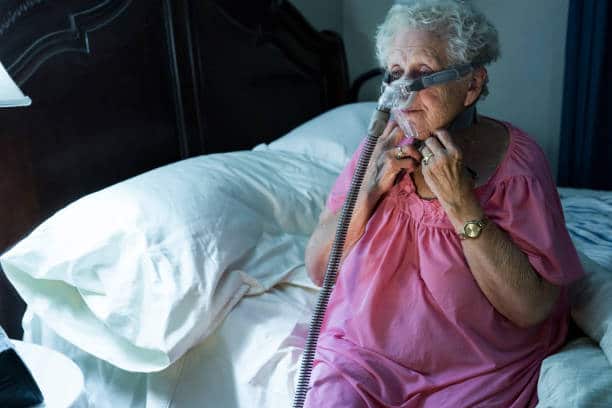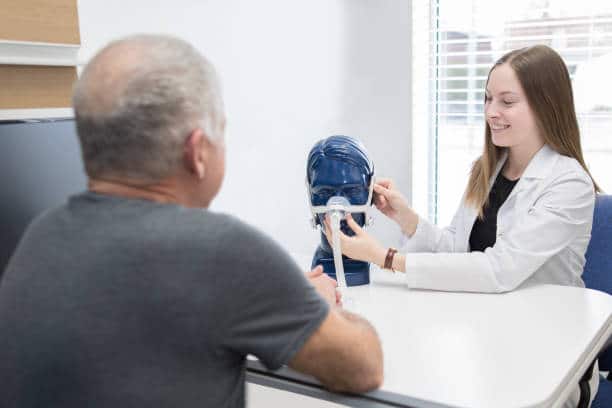Are you struggling to manage CPAP claustrophobia? Living with obstructive sleep apnea and using CPAP therapy can be challenging, especially when feelings of claustrophobia arise. However, it’s important to recognize that effective management of claustrophobia can significantly enhance your CPAP experience.
In this article, we will delve into the strategies and insights that can help you overcome CPAP-related claustrophobia, ensuring a comfortable and successful journey toward better sleep and overall well-being.
Unveiling Claustrophobia

Claustrophobia, an anxiety disorder characterized by an intense fear of enclosed spaces or situations that might induce a feeling of being trapped, can pose a significant challenge for individuals using CPAP therapy.
Claustrophobia stems from a deeply ingrained fear response within the human psyche. While the exact causes of claustrophobia can vary, triggers often include confined spaces such as elevators, tunnels, and even tight clothing. When applied to CPAP therapy, the sensation of wearing a mask that covers the face can evoke similar feelings of being trapped or restricted.
How Claustrophobia Can Impact CPAP Compliance
For individuals with claustrophobia, the prospect of wearing a CPAP mask can be daunting. The mask’s close fit and the sensation of being enclosed can exacerbate claustrophobic feelings, leading to challenges in adhering to CPAP therapy. It’s crucial to recognize that these concerns are valid and can hinder successful treatment outcomes.
Addressing Claustrophobia Concerns
Addressing claustrophobia concerns in the context of CPAP therapy is crucial for individuals seeking effective treatment for sleep apnea. Identifying the signs of CPAP-related claustrophobia is a crucial step toward effective management. Individuals may experience a range of emotional and physical responses, including:
- Anxiety and restlessness while wearing the face mask
- A sensation of confinement or difficulty breathing
- Avoidance of CPAP therapy due to fear
- Restless sleep patterns and daytime fatigue
Common Reasons Behind Claustrophobic Sensations
Claustrophobic sensations during CPAP therapy can be attributed to several factors, including:
- Mask Fit and Pressure: An ill-fitting mask or incorrect pressure settings can contribute to discomfort and feelings of confinement.
- Unfamiliar Sensations: The initial experience of wearing a CPAP mask might trigger unfamiliar sensations, leading to apprehension.
- Psychological Factors: Claustrophobia can be influenced by psychological factors such as previous traumatic experiences or anxiety disorders.
- Adjustment Period: It’s natural for the body to require an adjustment period when introducing a new element like most CPAP masks during sleep.
Learning from the experiences of others who have overcome CPAP-related claustrophobia can provide valuable insights and inspiration. Personal testimonials highlight the challenges individuals faced, the strategies they employed, and the positive outcomes they achieved. These stories serve as a reminder that managing claustrophobia is attainable and that different approaches work for different people.
Tried-and-True Solutions

Using a CPAP can feel challenging at first, especially if it makes you feel closed in. But you’re not alone in this. Many have been in your shoes and have found simple ways to adjust. Here’s a more detailed look at some steps to help ease into it:
1. Start Slow
- Begin by wearing the mask during relaxed times, perhaps when watching TV or reading. This helps you get familiar without the bedtime pressure.
- Over a few days, wear it a bit longer each time. Gradually, it’ll become just another part of getting ready for sleep. Remember, every minute counts, and soon, you’ll wonder why it ever felt strange.
2. Try Different Masks
- CPAP masks come in various styles and sizes. If one doesn’t feel quite right, another might be the perfect fit.
- Consider masks that cover less of your face; they can often feel less confining. Trying different options gives you the power to choose the most comfortable solution.
Try to read this: CPAP Mask Types: Everything You Need To Know!
3. Breathe Easy
- Focusing on your breath can be a game-changer. Before diving into sleep, spend a few moments taking slow, calming breaths.
- This simple practice not only relaxes your mind but also signals your body that it’s okay. Over time, this routine can create a bridge between you and a peaceful sleep.
4. Change Your Position
- The way you position yourself in bed can change how the mask feels. Sometimes, a minor tweak makes a big difference.
- Consider CPAP-friendly pillows or adjusting your bed’s angle. These minor changes can help the mask sit better, making everything feel more open and accessible.
Related: Best CPAP Mask for Side Sleepers
5. Talk About It
- Open up about any discomfort you’re feeling. Your doctor or healthcare provider is there to help.
- They can offer new insights, adjust the machine for you, or even guide you to a mask that might be a better fit. Speaking up means you’re taking an active step toward a better night’s sleep.
Sleep is essential, and the journey to finding your CPAP comfort is all about trying different things. Every step, big or small, gets you closer to those restful nights you deserve.
Alternative Therapies and Devices
For some individuals, despite the earnest tries and adjustments, the conventional CPAP device doesn’t quite hit the mark. It’s not a sign of defeat but rather an opportunity to explore a broader range of sleep therapy solutions. There’s a rich array of tools and techniques in the realm of sleep aid, and one of them could be your ideal fit.
Here’s an extended breakdown of the available alternatives:
BiPAP Machines
What It Is: This machine closely resembles the common CPAP, but it operates with a distinct twist. It’s designed to offer two different air pressure settings: one during inhalation and another during exhalation. This dual approach provides a rhythmic, more natural breathing experience.
Why Try It: Some people find the uninterrupted pressure of CPAP a bit taxing. The BiPAP, with its dual-pressure system, can be a more forgiving alternative. Additionally, its adaptable settings can adjust to varying pressure needs as you sleep.
Related Article: BiPAP Therapy: A Promising Treatment for Central Sleep Apnea
Dental Devices
What It Is: Think of these as custom-made mouth protectors. They gently adjust the position of your lower jaw and tongue, ensuring a clear airway.
Why Try It: For those who aren’t keen on the idea of a full-face mask, these dental devices provide a more subtle solution. They’re especially suitable for travelers or those with mild sleep apnea since they’re compact and easily portable.
Positional Therapy
What It Is: A strategy that involves making slight adjustments to how you sleep. This might require special pillows or wearable aids to maintain a posture that doesn’t obstruct your airways.
Why Try It: Some individuals find relief just by changing their sleeping position. It’s a simple, non-invasive method. If you often wake up gasping for breath when lying in a particular position, this therapy might be the relief you need.
Lifestyle Changes
What It Is: Deliberate personal changes, such as weight management, reducing alcohol intake, or quitting smoking.
Why Try It: These positive changes don’t just benefit your sleep but also enhance your overall health. Numerous users have reported marked improvements in their sleep apnea symptoms after adopting healthier lifestyle choices.
Surgery
What It Is: A range of surgical options aimed at creating a wider air passage by removing or adjusting tissue in the mouth breathing throat.
Why Try It: Surgery becomes a consideration when other treatments haven’t yielded the desired results or if there’s an evident anatomical reason causing sleep apnea.
Related Article: Revitalizing Sleep: Exploring Sleep Apnea Surgery
Why Are Support And Persistence Important?

Finding the right sleep solution can feel challenging. But it gets easier with good people around you and a never-give-up attitude.
Seeking Support
This means talking to doctors, joining local or online groups, and chatting with friends or family. These people can give advice, share their stories, or listen. It’s helpful to know that others understand what you’re going through. Just a simple chat can give you new ideas or make you feel better.
Staying Persistent
Trying to solve sleep problems doesn’t always work on the first try. It’s essential to keep going, even if it gets tough. If one method doesn’t help, try another. Celebrate the small wins, like feeling a bit more rested one morning. Over time, with effort and patience, you’ll find what works best for you.
In short, better sleep every night is possible with the right help and a strong will. Remember, you’re not alone in this journey; every step forward counts.
CPAP Mask Options

Choosing the right CPAP mask is pivotal in addressing claustrophobia concerns and ensuring a comfortable CPAP experience. With various mask options available, individuals can select the style mask that aligns with their preferences and enhances their CPAP therapy journey.
CPAP masks come in different styles, each catering to specific comfort levels and requirements:
- Nasal Pillows: These small, lightweight inserts rest gently under the nostrils, making them an excellent choice for minimal facial contact and ease of movement.
- Nasal Masks: Covering the nose, these masks offer a balance between compact design and effective airflow delivery.
- Full-Face Masks: Enveloping both the nose and mouth, these masks are ideal for individuals who breathe through their mouths during sleep or prefer a more comprehensive seal.
Nasal Pillows, Nasal Masks, Full-Face Masks
- Nasal Pillows: Designed for minimal intrusion, nasal pillows suit those seeking an unobtrusive fit. They are also recommended for claustrophobic individuals as they offer minimal facial coverage.
- Nasal Masks: These masks provide reliable airflow delivery to the nose. They are comfortable for individuals who prefer a mask that covers the nose but not the mouth.
- Full-Face Masks: Offering complete coverage, full-face masks ensure effective therapy for mouth breathers. They can be beneficial for claustrophobic individuals who require a secure seal for optimal air pressure.
Incorporating CPAP Therapy Into Your Routine
Creating an optimal sleep environment is a pivotal factor in ensuring the success of your CPAP therapy journey. Beyond just wearing the mask, the surroundings in which you sleep play a crucial role in your overall comfort and therapy effectiveness.
Bed Setup for CPAP Success
One of the first steps in incorporating CPAP therapy into your routine is ensuring your bed is set up for success. Position your bed strategically, allowing easy access to power outlets for your CPAP device. This not only ensures convenience but also minimizes cord tangling and potential disruptions.
A Dark Oasis
Light can significantly impact your sleep quality. Incorporate blackout curtains into your sleep environment to minimize external light sources that might interfere with your sleep patterns. This darkness supports the production of melatonin, the hormone responsible for regulating your sleep-wake cycle.
Temperature and Humidity
Your sleep environment’s temperature and humidity levels can greatly influence your comfort. Maintain a comfortable room temperature that aligns with your preferences and promotes restful sleep. Additionally, consider investing in a humidifier to keep the air sufficiently moist, preventing dryness and nasal discomfort.
Expert Insights
- Prioritize Comfort: Among the foremost recommendations from sleep specialists is to prioritize comfort when choosing a CPAP mask. The selection of a mask with the right fit and style can significantly diminish feelings of confinement and promote overall therapy acceptance.
- Mask Customization: Expert sleep specialists guide individuals through the intricate process of adjusting the CPAP mask’s fit and pressure settings. Such customization not only optimizes comfort but also works to alleviate any discomfort stemming from claustrophobic sensations.
- Desensitization Techniques: Gradual exposure serves as a powerful technique recommended by sleep specialists. This entails commencing with short periods of mask wearing during wakeful hours and progressively extending the duration. Such an approach aids in normalizing the presence of the mask and mitigates feelings of entrapment.
Professional Guidance For Managing Claustrophobia
Addressing claustrophobia within the context of CPAP therapy requires the guidance of experienced professionals. Sleep specialists provide targeted strategies that directly tackle claustrophobic reactions in the context of therapy:
Cognitive-Behavioral Techniques
Among the recommended interventions is cognitive-behavioral therapy (CBT), which assists in reframing negative thoughts associated with mask usage. Gradual reduction of anxiety is a central aim of this approach.
Relaxation Training
The teaching of relaxation techniques by specialists stands as another effective tool. These techniques are designed to ease anxiety and tension related to mask usage, facilitating a greater sense of ease and comfort.
Gradual Exposure Strategies
Professionals frequently advocate the systematic implementation of gradual exposure to the mask. This structured approach assists individuals in becoming progressively accustomed to the mask’s tactile sensations, thereby reducing apprehension.
Take Control Of Your CPAP Experience
In the journey of CPAP therapy, managing claustrophobia may seem daunting. Yet, with empowerment, proactive steps, and a resilient mindset, it becomes possible to reshape your experience. As you harness the power of CPAP, know that claustrophobia can be subdued. With informed strategies and expert advice, you’re more than capable of facing this challenge. To further enhance your therapy and confront these challenges head-on, consider equipping yourself with the finest CPAP accessories from this dedicated store, ensuring a path to restful sleep and a better quality of life.
Frequently Asked Questions
Quality of life is immensely influenced by the sleep we get. For those undergoing CPAP treatment, the choice of equipment and understanding of its features play a significant role. Here’s a brief look into the common queries:
What Mask type is important to help your CPAP claustrophobia?
Nasal masks and nasal pillows often feel less restricting compared to face masks. If you find your CPAP mask bothers you or CPAP mask makes you feel confined, you may need to switch types. It’s worth noting that most CPAP masks are crafted with the user’s comfort in mind.
Do you really benefit from the CPAP ramp feature?
Absolutely. Many users find it easier to fall asleep when the CPAP treatment pressure increases gradually, making the overall experience more comfortable.
How to get used to having the CPAP mask on your face?
Starting off with a nasal mask, which offers less coverage than other masks, can be helpful. Wearing it for short durations during relaxed moments can make the transition easier.
Should I Use a CPAP Mask with protection against asphyxiation?
Yes. Always ensure the type of mask you choose comes with built-in safety features. It’s crucial for ensuring continued breathing, even if there are machine disruptions.
What are the common CPAP mask problems?
Besides the feeling of confinement, other issues can arise, such as skin irritations or dryness. Integrating a heated humidifier into your setup or opting for a different mask type, such as nasal pillows, can address these concerns.
What are your key takeaways from this article?



